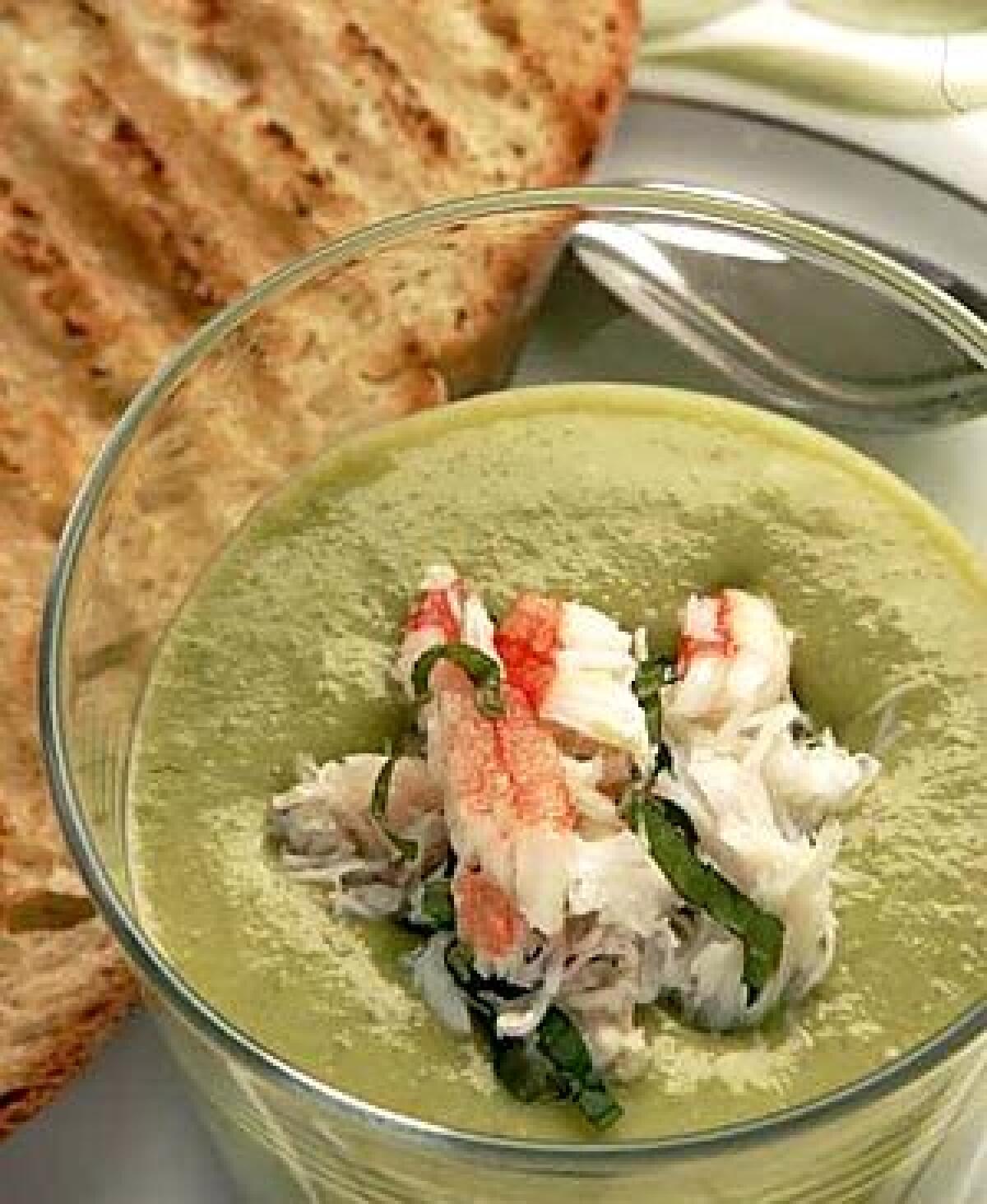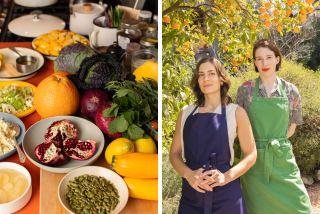Ready to get fresh? Time to flirt with spring soups

A vivid emerald bisque with a texture so luscious you’d never guess it was made without a drop of cream. A chunky chowder rich with the earthy flavor of freshly dug potatoes and the pungent sweetness of green garlic. A fragrant shrimp broth enlivened by artichokes and tender gnocchi perfumed with fresh spring herbs.
This is the season when a young man’s fancy turns to love, but I can’t stop thinking about soup.
Maybe, as my daughter tells me, it’s a sign of advancing age. But I think this obsession has more to do with spring vegetables showing up in the markets.
During the chilly winter months, cooks have had to work to get flavor -- roasting, caramelizing, simmering for hours. Now, with all of this vibrant spring produce at our fingertips, that same intensity of taste is ours for the asking.
Green garlic slender as scallions, little artichokes no bigger than a billiard ball, potatoes with skins so tender you can rub them off with a thumbnail -- the farmers markets are full of soup fixings just waiting for a pot. Just add water, indeed.
Spring soups made from these kinds of ingredients come together in a flash. They can be made low in calories and even vegetarian without diminishment of flavor.
And they allow all kinds of improvisation. By following a few broad guidelines, you can make a spring soup from just about any vegetable you choose from the farm stall or pluck from the garden.
For the sake of simplicity, let’s focus on three types of soup: We’ll call them broths, chowders and bisques. In broths, the vegetables are suspended in a clear soup. In chowders, they are coarsely puréed so the soup is thick but chunky. In bisques, the purée is so silky smooth the texture is almost creamy.
These definitions are based on classical precepts but are by no means textbook. Think of them as general descriptions that will adapt to suit many different ingredients. Unless you’re a real stickler, the fact that you won’t find them in Escoffier shouldn’t detract from your enjoyment one bit.
Broth with character
A BROTH is the simplest and most adaptable. Keep the stock fairly simple and straightforward to avoid overwhelming the flavor of the vegetables. Chicken, vegetable or fish stocks are good. Even better is a last-minute stock created by simmering the vegetable peelings in a weak broth or water.
You can use most any spring vegetable -- asparagus, artichokes, fava beans, peas, even delicate greens. If you’re only using one or two vegetables, cook them in the broth; they’ll lend their character to it. But if you’re using more than a couple, blanch the vegetables separately before adding them to the soup to keep them from blurring and losing their distinction (in this case, it’s too many vegetables that will spoil the broth).
Most of the time you’ll want to include a starch of some kind to give the broth a little more substance. New potatoes will work well, and so will pasta or rice. Cook them before adding them to the soup -- otherwise, they’ll cloud the broth.
In the shrimp and artichoke soup recipe, the starch is a little fancier -- light ricotta gnocchi with fresh herbs. It sounds complicated, but making it is simple: Beat together a stiff batter and then roll it into balls between your hands.
Gnocchi cook in less than a minute. When you add them to the boiling water, they’ll sink straight to the bottom. But within 20 to 30 seconds, they’ll lighten and begin to bob to the top. When they stay there -- 45 to 60 seconds -- remove them with a strainer and cook the next batch.
The stock is even easier. Simply simmer shrimp shells with some aromatics and the trimmings from the fresh herbs you used in the gnocchi. It’ll be rich and fragrant in about half an hour.
Chowders, our second category of spring soup, are almost as simple to make. Cook potatoes and one or two other vegetables in a broth, then purée them just enough to make a chunky mix.
There are a couple of tricks here. First, make sure the ingredients are cut to roughly the same size so they’ll cook and purée in about the same amount of time. Most important, when it comes to puréeing, remember that less is more. You want to purée just enough to release starches that will thicken the broth. But there should be easily identifiable chunks of vegetable left in the soup.
This is most easily done with an immersion blender -- one of those wands that you submerge in the soup pot. With this piece of equipment, you can see what the texture is and stop puréeing when you’ve got it just right. But you can also purée the soup with a food processor or blender as long as you keep it on pulse. Just two or three flicks of the switch should be enough. And, in a pinch, you can use an old-fashioned wire potato masher.
Make a chowder with new potatoes and green garlic and you’ve got a more assertive version of the classic French potage parmentier -- minus all that heavy cream at the finish. Instead, drizzle it with a thread of really good, aromatic olive oil and then sprinkle salty pecorino Romano over the top.
Green garlic comes in a range of shapes, depending on maturity. Right now, it is mostly scallion-slim, and the green tops are very tender. Later in the spring, the bulb will begin to swell, and the tops might be a little tough. If that’s the case, simply chop the bulbs a little finer and discard the tough greens.
Truly new potatoes are freshly dug and have not been cured by drying. Their skins will be very tender, the flesh moist, and the taste will have a slightly bitter finish that is a nice contrast to their earthy sweetness. But if you can’t find new potatoes, any waxy potato will do in this recipe.
Bisques, another versatile category of spring soups, require a little more careful handling. Traditionally, bisque soups were made by cooking the shells of shrimp, crab or crayfish and then thickening that broth with puréed rice and a lot of cream. You can do much the same thing with spring vegetables and do away with the cream altogether.
Though classic bisques are made with shellfish shells, this vegetable bisque is made with shells from English peas and then garnished with shellfish. That’s the kind of culinary punning that normally gives me a headache, but in this case, the result is so delicious I don’t mind.
If you can’t find Dungeness crab meat, shrimp will do nicely (and you can add the shells to the pea husks when you’re making the stock).
The secret to a really fine bisque is careful straining of the soup after it’s been puréed. Rubbing the mixture through a regular kitchen strainer will result in a very nice purée, but the finer the strainer, the smoother and silkier the resulting soup will be. This is one of those dishes where a woven steel chinois may be worth its exorbitant price.
The bisque challenge
THE other tricky part of making a bisque is figuring how much rice you’ll need to thicken a given quantity of liquid. Because starch from the vegetables will also contribute some thickening, this will vary, but a good ballpark estimate is about a quarter cup of rice to six to eight cups of broth.
Because the rice will be puréed along with the vegetables, cook them in the same pot. But note that the rice will probably take much longer to cook, so you should start it first. And forget about your dry, separate grains; this isn’t a pilaf. This is one time you want to overcook the rice so it will be soft enough to purée easily. Watch for the ends of the rice to crack and blow out; that’s the best indication the rice is sufficiently softened.
Remember also that bisques can be served cold as well as hot, but a chilled bisque will be much thicker than it is when warm, so save a little of the reserved broth to thin the soup if necessary.
For any soup, it’s important to taste and adjust seasoning just before serving, since taste is so temperature-dependent. And that seasoning should almost always include not just salt and pepper, but a jolt of acidity as well. It only takes a squirt of lemon or a drizzle of vinegar to pull flavors into focus.
This final seasoning is particularly important with the bisque. The right balance of salt, lemon and sugar makes a soup that is vibrant without having one of those flavors dominate. The sugar, in particular, is only there to lend a roundness to the flavor. The soup shouldn’t taste any sweeter than fresh green peas normally do.
It all comes together so easily you’ll probably be surprised. But it’s love that takes work; soup should be simple.
More to Read
Sign up for The Wild
We’ll help you find the best places to hike, bike and run, as well as the perfect silent spots for meditation and yoga.
You may occasionally receive promotional content from the Los Angeles Times.











